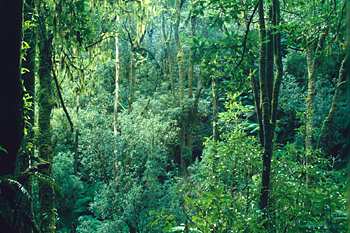
Otway Reserve Systems
Western Victoria devoid of native vegetation
Public land in the Otways is about 160,000 hectares (ha). That seems like a lot of land. However a look at natural landscapes in Western Victoria reveals most natural vegetation has gone with very little original native forest vegetation left.
Western Victoria covers about 5.7 million ha. Since European settlement began in the 1830's, 83% or 4.68 million ha has been converted to private property and is now mostly cleared agricultural land. Of what remains, only 7.1 % or 411,000 ha is State Forest and 7.6% or 436,829 ha is within legislated conservation reserves. The Grampians National Park is the largest reserve and takes up more than half of this reserved public land.
Only a small proportion of tall mountain forests remaining in the Otways are protected from logging. Link
Source: Comprehensive Regional Assessment; Volume One; July 1999; Table 2.1.

Forest with a lot of epiphytes growing on the trees - Riley's Ridge.
Existing Legislated Reserves in the Otways
In the Otways region there are a number of categories of reserve. These include National Parks, State Parks, Flora and Fauna reserves and scenic reserves.
See a full list of reserves in the Otways that are protected under legislation and a map(to be developed) of existing reserve system.
The West RFA process did not create any new reserve for the Otways. Link
OREN firmly believes the legislated reserve system in the Otways is not adequate and fails to protect:
Wildlife Corridors
Endangered Species
Domestic Water Catchments
Rainforest
Tourism Values
etc.
Management of conservation values within the
Otway State Forest
The Otways State Forest is not a reserve but publicly owned forest, managed for logging by Forestry Victoria, a division within the Department of Natural Resources and Environment (DNRE).
General protection of Flora and Fauna within the Otway State Forest comes under the flawed Comprehensive Adequate Representative(CAR) Reserve System which operates as a part of the West Regional Forest Agreement.
State Government processes to protect endangered species within State forest all point to the Flora and Fauna Guarantee Act to provide direction.
The concept of Ecologically Sustainable Forest Management (ESFM) is used by Forestry Victoria to justify continued clearfell logging in state forest.
Otway tall mountain forests lacking protection
Every year three square kilometres(300 hectares) of forest is clearefell logged - an area bigger than the Melbourne Central Business District.
The native forest logging industry often justifies this clearfell logging by making statements such as 'there is 156,000 ha of public land for which 73% is in reserves and only 300 ha is logged every year'.
Although it may sound as though there is a lot of public land in reserves, much of the reserved land protects vegetation that is not suitable for logging. For example the Angahook-Lorne State Park and Otways National Park have a high proportion of coastal heath and foothill forests, which would never be considered for logging. The Port Campbell National Park is mostly heathland and there are definitely no trees on the (twelve apostles). The Carlisle State Park is more than half heathland and the Angahook Heath reserve is, as the name suggests, is heathland.

Heathland and stunted trees make up most of
the 73% of public land within reserves (Otway Forest management area).
This type of ecosystem contains non-commercial timber species of no interest
to the native forest logging industry.
|
Of the tall wet forests in the Otways where the mountain ash, mountain
grey gum and tree ferns grow, only about 20%
is protected in reserves. Clearfell logging of three square kilometres
a year in the Otways targets these tall mountain forests.
Typical tall mountain forest that is targetted for clearfell logging. |
 |
Propaganda directory
Water yield and logging
tourism.
Don't know the meaning of a word? Check the glossary.